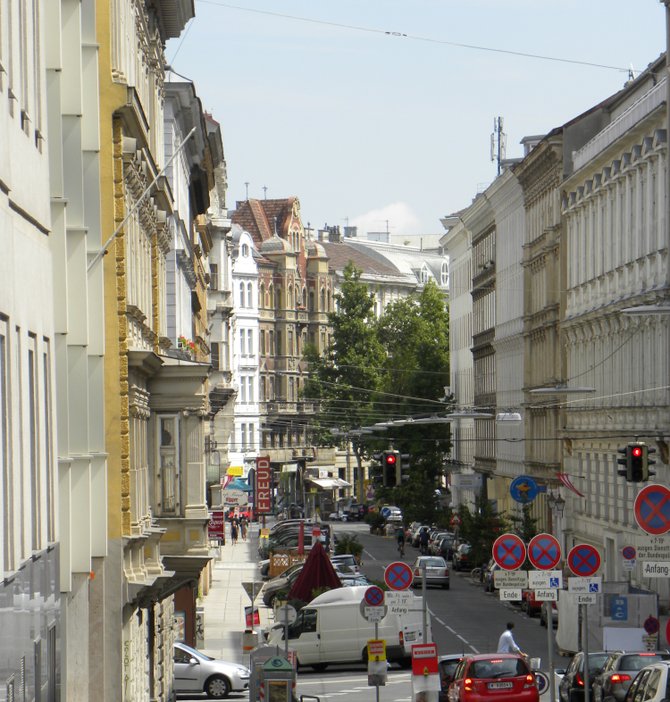 Facebook
Facebook
 X
X
 Instagram
Instagram
 TikTok
TikTok
 Youtube
Youtube

Vienna, Austria, is a dreamlike city filled with two imperial palaces, one hundred art museums and countless Viennese cafes. So where do you begin for only a few days’ visit? If, like me, you’re married to a psychiatrist, the answer is obvious: you take the Sigmund Freud tour.
The founder of psychoanalysis, Sigmund Freud (1856-1939), lived with his parents somewhere in the Jewish Quarter until the age of twenty-seven.
We visited the Vienna Synagogue with its impressive blue dome inside. The building is pressed between two apartment houses in compliance with King Joseph II’s edict that only Roman Catholic churches could have facades fronting public streets.
Thereafter, we walked to Judenplatz, which had a commemoration to the 65,000 Austrian Jews who died during the Holocaust.
Freud’s father was a poor wool merchant in this district who dreamed of his son becoming well educated. Freud didn’t disappoint, studying medicine at the nearby University of Vienna, an institution known for its Noble Prize winners.
Today you can wander through cavernous hallways or admire the busts of illustrious professors that surround a courtyard where Freud likely lingered. He was not, however, a full professor until one year after he retired from teaching; even during his time, scholars considered his theories controversial.
At the age of thirty-five, Freud moved with his wife into a 4,000-square-foot flat on the mezzanine floor of Berggasse #19. He established his psychoanalytic practice in a few rooms, which were kept separate from the family quarters.
Thanks to the efforts of Freud’s daughter Anna, in 1971 this flat became a museum and visitors still must ring the doorbell in order to enter. The family rooms contain a large library. Freud’s workrooms include a waiting room where his cane stands behind glass, a consulting room with an exhibit of his life, and an empty study.
The musty smell is gone even though the psychoanalyst purportedly smoked twenty cigars per day, experimented with cocaine, and wrote prolifically, including what he considered to be his most brilliant work: The Interpretation of Dreams.
Freud often walked along Ringstrasse, sometimes visiting the famed Landtmann Café where waiters now wear tuxedoes and fresh flowers perfume each table. He also stopped often at the Kunsthistorisches Museum that houses a vast art collection, including Egyptian, ancient Greek and Roman artifacts.
A compulsive buyer of antiquities, Freud regularly scoured the city for collectibles, and he had over 2,500 copies of statues from ancient civilizations scattered across his workrooms, some even strewn on the floor because he ran out of space.
The antiquities, like the couch, are not in Vienna, but remain in the London house where Freud lived after he escaped from the Nazis in 1938.
Finally, the Sigmund Freud Park, a few blocks from Berggasse #19, may have been where the psychoanalyst ruminated over his analysands. We ended our tour here, picking up a city-issued lawn chair and, surrounded by grass and trees, dreamt the rest of our afternoon away.


Vienna, Austria, is a dreamlike city filled with two imperial palaces, one hundred art museums and countless Viennese cafes. So where do you begin for only a few days’ visit? If, like me, you’re married to a psychiatrist, the answer is obvious: you take the Sigmund Freud tour.
The founder of psychoanalysis, Sigmund Freud (1856-1939), lived with his parents somewhere in the Jewish Quarter until the age of twenty-seven.
We visited the Vienna Synagogue with its impressive blue dome inside. The building is pressed between two apartment houses in compliance with King Joseph II’s edict that only Roman Catholic churches could have facades fronting public streets.
Thereafter, we walked to Judenplatz, which had a commemoration to the 65,000 Austrian Jews who died during the Holocaust.
Freud’s father was a poor wool merchant in this district who dreamed of his son becoming well educated. Freud didn’t disappoint, studying medicine at the nearby University of Vienna, an institution known for its Noble Prize winners.
Today you can wander through cavernous hallways or admire the busts of illustrious professors that surround a courtyard where Freud likely lingered. He was not, however, a full professor until one year after he retired from teaching; even during his time, scholars considered his theories controversial.
At the age of thirty-five, Freud moved with his wife into a 4,000-square-foot flat on the mezzanine floor of Berggasse #19. He established his psychoanalytic practice in a few rooms, which were kept separate from the family quarters.
Thanks to the efforts of Freud’s daughter Anna, in 1971 this flat became a museum and visitors still must ring the doorbell in order to enter. The family rooms contain a large library. Freud’s workrooms include a waiting room where his cane stands behind glass, a consulting room with an exhibit of his life, and an empty study.
The musty smell is gone even though the psychoanalyst purportedly smoked twenty cigars per day, experimented with cocaine, and wrote prolifically, including what he considered to be his most brilliant work: The Interpretation of Dreams.
Freud often walked along Ringstrasse, sometimes visiting the famed Landtmann Café where waiters now wear tuxedoes and fresh flowers perfume each table. He also stopped often at the Kunsthistorisches Museum that houses a vast art collection, including Egyptian, ancient Greek and Roman artifacts.
A compulsive buyer of antiquities, Freud regularly scoured the city for collectibles, and he had over 2,500 copies of statues from ancient civilizations scattered across his workrooms, some even strewn on the floor because he ran out of space.
The antiquities, like the couch, are not in Vienna, but remain in the London house where Freud lived after he escaped from the Nazis in 1938.
Finally, the Sigmund Freud Park, a few blocks from Berggasse #19, may have been where the psychoanalyst ruminated over his analysands. We ended our tour here, picking up a city-issued lawn chair and, surrounded by grass and trees, dreamt the rest of our afternoon away.
Comments